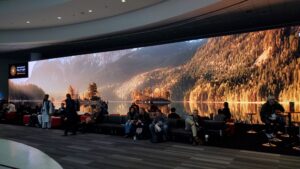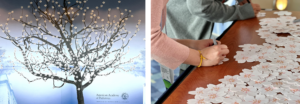
In the first post in our series about strategic meeting design, Projection’s Director of Creative Services, Joe Faulder, highlighted why we need to think differently about planning and executing meetings today to create the kind of experiences attendees talk about, promote, and return to.
Then, in our second post, he made the argument that the general session (GS) can serve as the first step to a more strategic meeting. To lay the groundwork for a more strategic event experience, a GS (or plenary) should integrate an event’s vision components into an emotive experience that creates a meaningful connection between attendees and your association, and leaves them excited for what they will experience over the coming days.
But the GS is just the beginning. If attendees leave that room feeling excited and inspired – only to have the rest of the meeting disconnected from what they just experienced – those feelings will fade quickly, and the overall attendee experience will fall flat. The risk of that, of course, is that they will begin to question the value in attending next year’s event and possibly even their membership altogether.
To ensure a more consistent experience for attendees, and one that aligns with your organization’s strategic goals and initiatives, here are some things to keep in mind when designing your meeting beyond the GS.
Tie into your theme consistently and purposefully
Every memorable experience is built around a theme. Whether it’s something communicated explicitly, or wrapped into content and design, a theme helps meeting planners design a purposeful event, and attendees have a purposeful experience. A well-chosen (and executed) theme serves as a blueprint for the entire meeting, from the GS to the closing remarks.

White Coat Rally, AAP
Once a theme is selected, the content, activations, performances and experiences should tie back so that, no matter where an attendee is along their event journey, the experience is consistent. One example is the 2023 American Academy of Pediatrics’ (AAP) National Conference & Exhibition. This year’s theme was advocacy, so the keynotes, activations, and experiences – such as a white coat rally for pediatricians on the Capitol – all revolved around the idea that pediatricians are advocates for children.
Think like an attendee
As we all know, the attendee experience is critical to the success of your event; for some, a positive attendee experience is integral to the future of the meeting itself. Therefore, it’s so important for us to ensure that every part of their journey – before, during and after the event – is well planned, purposeful, and easy to navigate. One way to do that is to put yourself in the shoes of someone who will be attending your meeting and walk through each step.
For example, when attendees arrive at the venue, is it easy to find registration? When they walk out from the GS on their way to an afternoon of breakout sessions, can they easily find their way from one to another? Do they have enough time to get to their desired sessions? If they have to think too hard about where to go and how to get there, all that work to inspire them during the GS is instantly lost.
One way to ensure logistics do not impede an attendee’s experience is to address them before the GS kicks off. For example, make sure registration staff proactively connects with people as they check in and start the GS with a few admin items, including how to get around, where to go for additional information and important event reminders. In addition, use digital signage to help attendees navigate the venue; they should be able to easily see what sessions are happening throughout the day/meeting.
Transform the venue
The venue is your meeting’s canvas; as much as possible, think about it in terms of enhancing the attendee experience, not simply facilitating it. Ideally, as attendees go from room to room, session to session, it should be obvious that they are at your organization’s event. Leverage physical and digital signage, video screens and extra space to tie in your organization’s brand and the meeting’s theme.

International Day of Light Photo Contest, SPIE
For example, SPIE, the international society for optics and photonics, has leveraged technology – an LED wall – to create a breathtaking moment for attendees as they walked into the lower lobby of the convention center. Not only was the wall visually stunning, but the content being shown tied back to the people at the event – scientists who study light. LED signage enhanced with graphic animations is also used throughout the SPIE conference, not only to carry over the branding and messaging of SPIE, but to provide important directional and session information to attendees.
Another example is the American Heart Association (AHA) who organized their content by heart chamber. Each chamber was associated with one color, and all related content was represented on maps of the event and signage throughout. By doing so, attendees could easily identify which content was most relevant to them and make finding where they were going more fun.
Add activations that enable attendees to define their own experience
No matter how much you understand the people coming to your event, the reality is that each attendee will come with their own goals and agenda for their experience. Therefore, it’s important that you provide multiple opportunities for them to write their own story. One way to do that is with activations that allow them to define their own experience with the vision, theme, and content.
This year, while in Washington, DC for their annual conference, the AAP created an advocacy tree. Designed as a cherry blossom, attendees were asked to write what they personally wanted to advocate for on behalf of children in the future. Every blossom was meant to represent a different form of advocacy for children.

Advocacy Tree, AAP
By adding opportunities for attendees to get involved and add their own voices, they become part of the event, not just a bystander, with the theme carried through everything.
Create opportunities for fun
Even if attendees are at your meeting to learn, it’s critical to create opportunities for fun. While they may remember some of the valuable insights learned during breakout sessions, it’s the moments of elevated emotions – like fun – that will stick with them long after the closing remarks.
For example, consider adding an element (or two or three) of fun to your event’s opening or evening events. SPIE designs its annual opening reception around a theme, which creates an immersive experience, rather than the traditional networking-while-eating and drinking. One year, the theme was video games, so they set up an LED screen with Wii tennis, turned the stage into a tennis court and hired an actor to portray Fabio (complete with the blond wig) to give attendees tennis lessons. Another year, the theme was Star Trek; attendees walked through a warp speed tunnel in order to enter the ballroom where they were treated to slideshows linking technologies in Star Trek to innovations spearheaded by members of their organizations.
Design a journey around shared values
Each organization and meeting have a set of shared values that hold members together. It’s important that those are woven throughout each year’s event, so it’s always top of each attendee’s mind why they are there, why they keep coming back, and why they are a member of this unique and valuable group.
Like SPIE with the LED wall and AAP with the advocacy tree, find opportunities to create and share content, design activations, and cultivate fun that demonstrate the values you all share.
As meeting professionals, we know how critical the attendee experience is to the future of our event. As a result, we can no longer dust off and re-use last year’s meeting to-do list and expect that our attendees will keep coming back. Rather, we need to be purposeful in the design and execution of our meeting. While these are just some of the ways to create an experience that will keep attendees engaged and coming back, I hope these get you started on the right path.
More from our strategic meeting design series
[Part One] The Importance of Thinking Strategically About Your Meeting – and How to Get Started
[Part Two] Why Your General Session Should Serve as the First Step to a More Strategic Meeting
[Part Four] After the meeting: Keeping brand awareness, momentum and energy going
